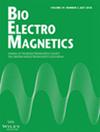Jody C. Cantu, Ibtissam Echchgadda, Joseph W. Butterworth, Jason A. Payne, Leland R. Johnson, David A. Freeman, Weston C. Williams, Brad W. Hoff, Robert J. Thomas, William P. Roach, Bennett L. Ibey
求助PDF
{"title":"高峰值功率微波(HPPM)对溶液中病毒灭活作用的研究","authors":"Jody C. Cantu, Ibtissam Echchgadda, Joseph W. Butterworth, Jason A. Payne, Leland R. Johnson, David A. Freeman, Weston C. Williams, Brad W. Hoff, Robert J. Thomas, William P. Roach, Bennett L. Ibey","doi":"10.1002/bem.70015","DOIUrl":null,"url":null,"abstract":"<div>\n \n <p>The recent severe acute respiratory syndrome coronavirus 2 (SARS-CoV-2) pandemic had a tremendous impact on human life and global economics, motivating the invention of technology that can limit the spread of the virus from human to human in public areas. One candidate for such a purpose is radio frequency (RF) radiation, which was previously suggested to have a significant impact on viral integrity at exposure levels considered non-damaging to humans. However, these publications provided a limited explanation of the mechanism of action resulting in viral inactivation during RF exposure. One hypothesis was that structure resonance energy transfer (SRET) was occurring between the incident RF waves and the viral particle, which is highly dependent on the incident electric field strength. In this paper, we report exposures of bovine coronavirus (BCoV) to high peak power microwave (HPPM) pulses to validate the dependence of viral rupture on peak electric field as a critical parameter driving SRET. We tested 0.1–1.5 MW, 2 µs pulsed exposures of viral-containing buffer at 2.8, 5.6, 8.5, and 9.3 GHz up to 100,000 pulses and found no evidence of clinically significant E-field dependent decreases in viral infectivity. The findings reported in this manuscript do not support the hypothesis that SRET is a dominant mechanism behind RF-induced viral inactivation. Bioelectromagnetics. 00:00–00, 2025. © 2025 Published 2025. This article is a U.S. Government work and is in the public domain in the USA.</p></div>","PeriodicalId":8956,"journal":{"name":"Bioelectromagnetics","volume":"46 6","pages":""},"PeriodicalIF":1.2000,"publicationDate":"2025-07-29","publicationTypes":"Journal Article","fieldsOfStudy":null,"isOpenAccess":false,"openAccessPdf":"","citationCount":"0","resultStr":"{\"title\":\"Investigation of Viral Inactivation by High Peak Power Microwave (HPPM) Exposure in Solution\",\"authors\":\"Jody C. Cantu, Ibtissam Echchgadda, Joseph W. Butterworth, Jason A. Payne, Leland R. Johnson, David A. Freeman, Weston C. Williams, Brad W. Hoff, Robert J. Thomas, William P. Roach, Bennett L. Ibey\",\"doi\":\"10.1002/bem.70015\",\"DOIUrl\":null,\"url\":null,\"abstract\":\"<div>\\n \\n <p>The recent severe acute respiratory syndrome coronavirus 2 (SARS-CoV-2) pandemic had a tremendous impact on human life and global economics, motivating the invention of technology that can limit the spread of the virus from human to human in public areas. One candidate for such a purpose is radio frequency (RF) radiation, which was previously suggested to have a significant impact on viral integrity at exposure levels considered non-damaging to humans. However, these publications provided a limited explanation of the mechanism of action resulting in viral inactivation during RF exposure. One hypothesis was that structure resonance energy transfer (SRET) was occurring between the incident RF waves and the viral particle, which is highly dependent on the incident electric field strength. In this paper, we report exposures of bovine coronavirus (BCoV) to high peak power microwave (HPPM) pulses to validate the dependence of viral rupture on peak electric field as a critical parameter driving SRET. We tested 0.1–1.5 MW, 2 µs pulsed exposures of viral-containing buffer at 2.8, 5.6, 8.5, and 9.3 GHz up to 100,000 pulses and found no evidence of clinically significant E-field dependent decreases in viral infectivity. The findings reported in this manuscript do not support the hypothesis that SRET is a dominant mechanism behind RF-induced viral inactivation. Bioelectromagnetics. 00:00–00, 2025. © 2025 Published 2025. This article is a U.S. Government work and is in the public domain in the USA.</p></div>\",\"PeriodicalId\":8956,\"journal\":{\"name\":\"Bioelectromagnetics\",\"volume\":\"46 6\",\"pages\":\"\"},\"PeriodicalIF\":1.2000,\"publicationDate\":\"2025-07-29\",\"publicationTypes\":\"Journal Article\",\"fieldsOfStudy\":null,\"isOpenAccess\":false,\"openAccessPdf\":\"\",\"citationCount\":\"0\",\"resultStr\":null,\"platform\":\"Semanticscholar\",\"paperid\":null,\"PeriodicalName\":\"Bioelectromagnetics\",\"FirstCategoryId\":\"99\",\"ListUrlMain\":\"https://onlinelibrary.wiley.com/doi/10.1002/bem.70015\",\"RegionNum\":3,\"RegionCategory\":\"生物学\",\"ArticlePicture\":[],\"TitleCN\":null,\"AbstractTextCN\":null,\"PMCID\":null,\"EPubDate\":\"\",\"PubModel\":\"\",\"JCR\":\"Q3\",\"JCRName\":\"BIOLOGY\",\"Score\":null,\"Total\":0}","platform":"Semanticscholar","paperid":null,"PeriodicalName":"Bioelectromagnetics","FirstCategoryId":"99","ListUrlMain":"https://onlinelibrary.wiley.com/doi/10.1002/bem.70015","RegionNum":3,"RegionCategory":"生物学","ArticlePicture":[],"TitleCN":null,"AbstractTextCN":null,"PMCID":null,"EPubDate":"","PubModel":"","JCR":"Q3","JCRName":"BIOLOGY","Score":null,"Total":0}
引用次数: 0
引用
批量引用

 求助内容:
求助内容: 应助结果提醒方式:
应助结果提醒方式:


